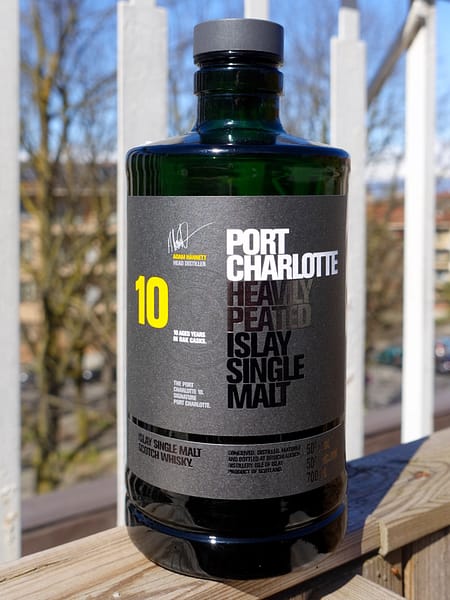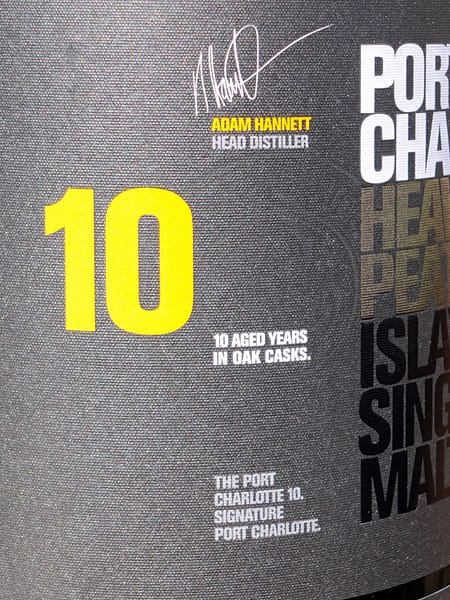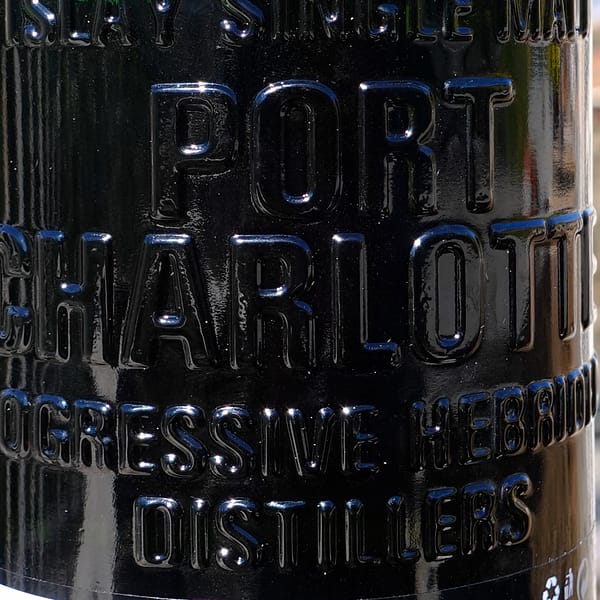In today’s review, I am looking at the Port Charlotte 10 year old Heavily Peated, or PC 10 for short, continuing the series on entry level standard distillery lineup whiskies. This much loved whisky uses a different source of peated malt from most of its Islay siblings and a non-traditional cask ageing regime. Like or dislike aside, I am curious to see how this translates into the glass.

TL:DR: A complex, potent and elegant take on Islay peated whisky.
Vote: 8, considering this is a standard regular release, this really is something special
The brand and the distillery
Port Charlotte is one of the three brands produced by the Bruichladdich distillery. It is used for the peated product line of the distillery. The other two brands, Bruichladdich and Octomore, cover the unpeated and super heavy peated ranges produced. Port Charlotte distillery, also known as Lochindaal, was operational between 1829 and 1929.
Bruichladdich originally planned to reopen the site, but due to changes with SWA regulations the idea was abandoned. The new SWA rules stated that the name on the label had to be consistent with the distillery where the spirit was distilled. Bruichladdich had already thousands of litres of “Port Charlotte” in the warehouse. Being unable to bottle this liquid under the new Port Charlotte distillery’s name, it would have had to be sold as “peated Bruichladdich”,and so the plans were shelved. (Editor Note: I originally wrote that Bruichladdich toyed with the idea of reopening Port Charlotte as a second distillery to expand production, but that the plan seemed to have hit a hard stop once Rémy Cointreau purchased the distillery – I am thankful to Paul Jarvis for the correction).
In the grand timeline of modern whisky Port Charlotte 10 is a relatively new addition. It was originally released on the market as a limited release in 2012, as the culmination of a row of increasingly aged releases (starting with PC5). Once Rémy Cointreau purchased Bruichladdich the Port Charlotte brand underwent a look and feel revamp in 2018, introducing the current squat dark glass bottle and label. Coincidentally, the PC10 became part of the regular lineup release.
A unique take on Islay
As I mentioned in the introduction, the PC10 is not your typical Islay dram, as both malt choice and cask ageing regime. Unlike many Islay distilleries, Bruichladdich does not source its peated malt from Port Ellen, instead using peated malt from the highlands. The difference in peat source potentially provides a very different fingerprint, as Islay peat is generally considered more maritime and medicinal while Highland peat is supposed to have more woody, vegetal and even floral notes. This also opens a window on the future of Islay peated malts, as Port Ellen malting availibility is scaled down (see below). The other aspect is the use of 25% of spirit aged in wine casks in the blend. While not unique to Bruichladdich, wine cask ageing is a distillery signature (see my previous Classic Laddie review). How does this impact the aromatic signature of the PC10?
Is the “Islay reek” about to change?
Many distillery on Islay and beyond use peated barley malted at Diageo’s Port Ellen facility for their whisky. Diageo’s own Caol Ila, Lagavulin and Talisker, together with Ardbeg, Laphroaig and Tobermory on Mull all apparently use Port Ellen’s malt today. That might not be the case for long. Diageo has restarted distilling operations at Port Ellen and communicated that it will reduce and potentially stop supplying maltings to distilleries outside of its own group. This 2022 Master of Malt article provides more detail.
What will this mean for Ardbeg, Laphroaig and possibly Tobermory? Will we see a move to other peat sources and a different taste profile? Will Port Ellen maltings expand to keep up with demand? The chance of some of Islay’s favourite distilleries having to switch to mainland peat is not as remote as it may seem. If that happens, the flavour character of these whiskies is likely to change too. Port Charlotte 10 may provide some insight on what may be the future signature of (at least some) Islay whiskies.
Without further ado, let’s dive into the review of the Port Charlotte 10 Heavily Peated
Port Charlotte 10 year old Heavily Peated



Specs
Price paid: 67€
Bottled date: 24/1/2022
ABV: 50%
Natural colour: Yes
Non-chill filtered: Yes
Casks Used: 65% first fill American whiskey casks, 10% second fill American whiskey casks and 25% second fill French wine casks
Tasting Notes
Colour: Bright intense gold, radiant.
Nose: Wow, this is intense and complex. I was worried it might be a bit hot at 50% ABV but it is far from it. Even before noticing the peat, I get the wine cask influence: wine gums, marzipan, a hint of raspberry. Then the peat arrives. Not the usual Port Ellen medical peat, but rather a rich creamy wood & vegetal smoke. There is a rich core of floral perfume (rose, heather) pine raisin and sweet spices. Yellow fruit notes, peach and pineapple, together with Bourbon cask notes of creamy vanilla and caramel.
Are we done? Not even close. As the whisky breathes it opens up even more. There is citrus, first mandarin then mix citrus marmalade. Finally, some sea spray and a hint of coastal iodine emerge, porridge oats and a touch of honey.
Contrary to other peated drams where I find the smokiness disappears with time, here the peat became more noticeable the more the spirit had a chance to breathe. This is an exceptionally aromatic dram, I would be happy even if I couldn’t drink it. But since I can…
Taste: On the palate, it is oily and intense, the 50% is noticeable but not hot. The taste is more what I expected from the heavily peated label. The peated character is immediately noticeable, again more woody and floral than medicinal. There is a noticeable coastal saltiness. Then again a complex range of flavours. The ex-bourbon spirit part of the blend takes a more leading role: peach and pineapple, vanilla custard, and lemon—then almonds and oak. The taste is rich, aromatic and slightly bitter.
Finish: Intense and long. The smoke is there but peeking through a veil of the floral perfume note and a rich peach. Again complex, with citrus, slightly mineral (salt and chalk) notes, lemon sherbet dip, and some wine gums. The mouthfeel has noticeable and very fine oak tannins, which I expect are coming from the wine cask.
Vote: 8. Complex, powerful and elegant at the same time. IS stating a standard release is Something Special too much? Sure, you could argue I am stretching the mark slighlty compared to other drams I have tried, but exactly because it is a standard lineup whisky, it deserves a special mention, And on top, this is one of those “happy dance” whiskies. When I drink it I wiggle from happiness. A definite Permashelf bottle.
* Votes are based on the scoring scale used by Dramface, slightly modified to allow half-points
My closing thoughts
I mentioned right at the start that, besides the recognition the Port Charlotte 10 gets, I wanted to review it to experience a different kind of peat from the “traditional” Port Ellen one and to taste how wine casks work with peat. Tasting this whisky over a few weeks told me two things. First, the difference in peat is noticeable, while the maritime character still comes through. It isn’t better or worse than the Port Ellen peat note, just different in an intriguing way.
The wine cask is extremely noticeable and works very well with the peat. Happy to have another cask/spirit combo that works to choose from. The choice of a second-fill wine cask is smart. I had a sample of Port Charlotte’s PAC:01, fully matured for two years in Pauillac (Bordeaux red wine) casks. This special edition impressed me a lot less: way too oaky and bitter, overpowering the elegant distillate.
But back to the standard PC10. It will remain for me one of those memorable drams that change your view on whisky. It made me realise that peat can be extremely complex, refined and still powerful and that this style really hits my sweet spot. The one aspect that made me think twice before deciding on my vote was the price. And it is my only complaint.
Here in Italy, and other European countries, the price is often in the 70-75€ range, close to the 60£ price on the Bruichladich UK online store. Compared to its Islay peers, even at 50% abv and as an integrity single malt, that is on the expensive side. I will argue it is still worth it, but that is my own take.
And then there is Germany, where PC10 can be had at just over 50€. German prices are usually lower but this is an unusually large difference. In any case, you catch why I am sharing this, don’t you?
Would I buy it again? Abso-frigging-lutely, without a shred of doubt. It will go on top of my re-stock list as soon as I get past the 1/3 fill mark.
Would I offer this to a new whisky drinker? Depends on how new. The 50% might be a bit much for an absolute novice coming from 40% malts. And probably having some experience with peat helps frame the PC10 in a more appropriate context. So, this is maybe not where I would start exploring Islay peat, but maybe one to try after the mainstream Laphroaig/Caol Ila/Lagavulins, to really appreciate it.
Stay tuned for another Islay “new” classic in a few days!
Interested in my take on a specific whisky style? Check the full Journey here and jump to the relevant Chapter.
I always find it interesting, after writing my tasting notes, to look at other opinions. Here are a few other reviews of the Port Charlotte 10 I enjoyed:
Dramface (side by side with Laphroaig 10)
If you have enjoyed this content, please share a comment below and consider supporting the cost of this blog via the button below
You mention the decision not to proceed with building a new Port Charlotte distillery in the village, however for the record this had nothing to do with the Rémy Cointreau acquisition in 2013. I was the designer of all the Bruichladdich brands from 2005-2020 – I created Port Charlotte so I was there at the time!
In fact we had planning permission for the PC distillery and I was at the ceremony where Jim McEwan “broke ground” for the build (this was the occasion for the release of the PC 5.5 “FIRST CUT” in 50ml, 27.05.07). However shortly after the SWA changed the rules, saying that the name on the label had to be the distillery where the spirit was distilled. We had hundreds of thousands of litres of PC already in the warehouse which now couldn’t be said to come from a new Port Charlotte distillery and would now have to be sold as “peated Bruichladdich” – which would have been confusing, with Port Charlotte just down the road.
So PC became a brand of Bruichladdich – and a wonderful dram it is to! Just a shame that we could resurrect the site of the old Lochindaal distillery, with a stunning new facility in the village of Port Charlotte.
Thank you for the insight Paul, I based what I wrote on what I was able to research online, but I am very thankful for the correction, which I will include in the post. It is indeed a shame that the site could not be resurrected!
Again, thank you for stopping by and taking the time to comment.